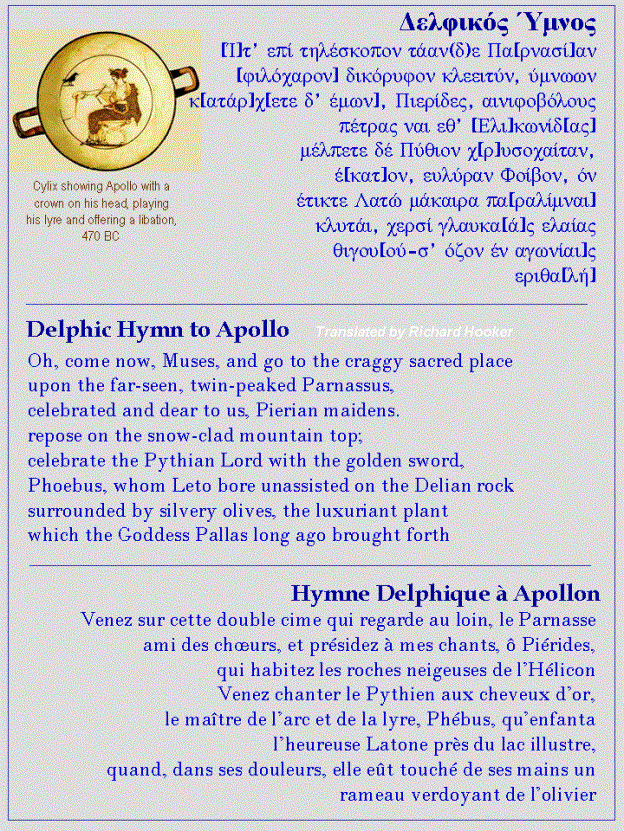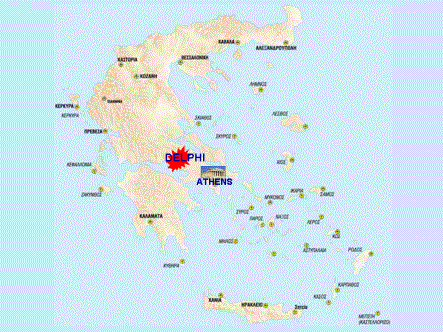
Delphi (Äåëöïß), a place of the World
Heritage, is one of the most beautiful and impressing landscapes of Greece.
It is situated on the Mount Parnassus, overlooking the olive tree valley that
stretches to the sea of Itea, a modern town by the central Corinthian Gulf,
where the ancient harbour of Kirrha was situated.
According to the ancient myth, Dias (Zeus)
released two eagles from opposite ends of the earth, one from the East and
the other from the West. At the point where they met, he threw the sacred
stone omphalos to locate the centre of the world, the navel (Gk: omphalos)
of the earth. It was at that point that the pan-Hellenic sanctuary of Delphi,
where the oracle of Apollo spoke, was developed. Blending harmoniously
with the superb landscape and charged with sacred meaning, Delphi in the 6th
century B.C. was one of the most important oracles of antiquity, a religious
centre and symbol of unity of the ancient Greek world.
Delphi was inhabited in the prehistoric times and during the classic times,
it obtained great importance. Apollo, the God of the genuine oracle, taught
people the metron: prudence and modesty, which became the most ethical
and peaceful expression of the Greek spirit.
The modern town of Delphi and the Archaeological
Site
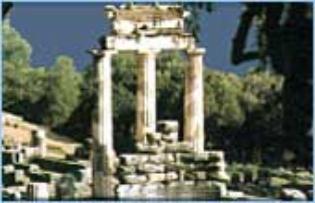
Still a remarkable location, Delphi is a headquarters for international
meetings, architectural, archaeological cultural symposia, congresses of ancient
drama held under the auspices of the European
Cultural Centre of Delphi that aims
at reviving Delphi as a European and International cultural centre with global
activities.
The modern Delphi is situated west of the archaeological site, passed by
a major road linking Athens
with Amfissa, the capital of the Prefecture
of Fokis,
along with Itea and Arachova.
Today, much of the splendour of Delphi survives, despite repeated raids.
The ruins of Delphi were uncovered by the systematic excavations of the French
Archaeological School, which began in 1893. The excavations revealed more
than five thousands inscriptions of all kinds, statues, several miniature
objects, architectural decorative pieces, all exquisite works of art, representing
the major cities of Greek antiquity. The Museum
of Delphi is one of the richest in the world, containing
exclusively findings from the site, including the navel of the world (a Hellenistic
or Roman copy of the Sacred Stone), the statue of Antinoos, the metopes from
the Treasuries of Sicyon and Athens, the Karyatid and Zephyr from the Treasury
of Siphnos, the bronze Charioteer (Iniohos), the head of Dionysos.
The visitor can still follow the steps of early worshippers and admire the
ancient monuments: the 7,000 spectators Stadium, with the gymnasium,
palaistra, running track and swimming pool, where the Pythian Games were hosted;
the Doric Temple of Apollo (4th century BC), where Pythia sat
on Apollo's tripod to deliver her oracular responses; a number of Treasuries
(small buildings, dedicated to the Sanctuary by various ancient countries
in order to keep the precious offerings); the Kastalia Spring, the
Doric Tholos of the Sanctuary of Athena Pronaia (a true architectural
masterpiece of antiquity, dedicated to a female deity); the 5,000 seat Theatre,
where the Delphic Festivals were held.
In the 1930’s, it was in this theatre, that the poet Angelos Sikelianos
and his wife, choreographer Eva Palmer revived the Delphic Festival for the
first time since antiquity, wishing to "instil the forgotten Delphic
watchword in all human souls". Their house still stands in the modern
town of Delphi. Like for Delphi, Eva and Angelos Sikelianos spread all around
the world, the reputation of the nearby small mountain town of Arachova, today a ski resort. Eva by teaching the
art of handmade woven articles; Angelos by his highly intellectual poetry.
At Livadi, close to Arachova, Coryceo Antro (Corycian Cave), a prehistoric
cave-temple dedicated to God Pan has been discovered. Lord Byron said about
the Arachovian women, that «they were very careful and polite» and the English
painter Rey wrote that «We cannot help admiring all the time the proud and
big stature of the men of this village. As far as the women are concerned,
they are able to become the best models in the art of sculpture».
Mythology and History of the Oracle

The first inhabitant of the area was either the goddess Gaia (Earth)
or Themis and the region was called Pytho (a rocky place in Homer’s
Iliad). During the Mycenaean period, the female
deity of Earth was worshipped in the small settlement of Delphi. The development
of the sanctuary and oracle though, began in the 8th century B.C. with the
establishment of the cult of Apollo.
The first Sibyl uttered prophecies,
guarded by her offspring, the chthonic serpent Python. In the Homeric
Hymn to Apollo, the god Apollo killed the Python, left it to rot (Gk: python,
to rot) and after purification, he took over the Oracle (Pythian Apollo), thus introducing the
worship of Delphinios Apollo
at Krisa (a town in Phokis, today
Hrisso). The area was called Delphi, possibly because Apollo appeared
in the form of a dolphin. In Greek delphis is the dolphin and also the womb;
distinguishing the dolphin from other sea-creatures as a mammal or indicating
the archaic veneration of Gaia at the site.
Another legend tells us that Apollo passed by the nearby Arachova when he
first went to Delphi and from the Katoptireon over Arahova shot his arrow
to kill the dragon in order to leave the water running free for the people.
Interestingly, in the Christian ages, Saint George killed the Dragon for the
same reason and he is worshipped by the local people to this day.
Apollo represented harmony, order and reason and he shared the sanctuary
with Dionysus, the god of wine, representing emotion and chaos, in
contrast or complementary, according to the Greeks, to Apollo. Every autumn
Apollo departed for his winter quarters, returning in the spring. During his
absence Pythia did not deliver oracles and Dionysus ruled over Delphi. In
590 BC, the Oracle was liberated from the domination of Krisa and the fame
of Delphi began.
Under the protection and administration of the Amphictyony (a religious
confederation of representatives of twelve Greek tribes, who met every spring
and autumn to vote on decisions which were executed by the Senate), the Pythian
Games and Delphic Festivals (comprising sacrifices, performance
of the Sacred Drama, whose main theme was Apollo's victory over Python, music
contests and paeans in honour of the god) were organized every four years,
in the third year of each Olympiad.
In 191 B.C., the Romans became masters of Delphi, and despite the attempts
to revive the Oracle, eventually it ceased to be regarded as the navel of
the world. With the spread of Christianity, the sanctuary lost its religious
importance and was permanently closed down with a decree of emperor Theodosius
the Great.

In the prophecy ceremony, visitors from all over the Mediterranean,
who wished
to consult the Oracle, paid the tax and were given the right to approach the
altar of Apollo to offer sacrifices. During the 8th-7th centuries B.C., the
sanctuary received dedications from legendary kings such as Gyges and Midas.
It was Apollo who gave the order, through the Oracle at Delphi, for Orestes to kill his mother Clytemnestra
and her lover Aegisthus.
After purification in Kastalia spring, (the spring to the East of
the sanctuary that takes its name from a girl of Delphi, who threw herself
into the spring to escape the unwelcome advances of Apollo), Pythia,
the prophetess
of Apollo, responded on behalf of the gods by bending over omphalos and inhaling
the hallucinating vapours of an open chasm. She entered a state of ecstasy
and uttered incoherent words, which were then interpreted in earlier times
into hexameter verse, later in prose by the Priest. The oracular responses
were ambiguous and interprets endeavoured to render some meaning out of the
prophecy. Heraclitus (c. 500 BC) said that Pythia never gave a straight answer.
The oracle neither concealed nor revealed
the truth, but only hinted at it. Herodotus reported of king Croesus of
Lydia who asked if he should invade Persia. The reply was, if he did invade
a mighty empire would be destroyed. Croesus thinking he would be victorious
invaded, but it was his own empire that fell and destroyed.
The prophetic power of the Delphic oracle was attributed to a fissure in
the bedrock, a gaseous vapour and a spring. Recent research has provided evidence
that the intoxicating gaseous emission was not a myth, since the site of the
oracle shows young geological faults
intersecting below the temple, possibly emitting in ancient times light hydrocarbon gases
from bituminous
limestone
which have intoxicating effects. The effects of ethylene inhalation match
the well-documented effects of the ancient prophetic vapours.
About Apollo (Áðüëëùí)
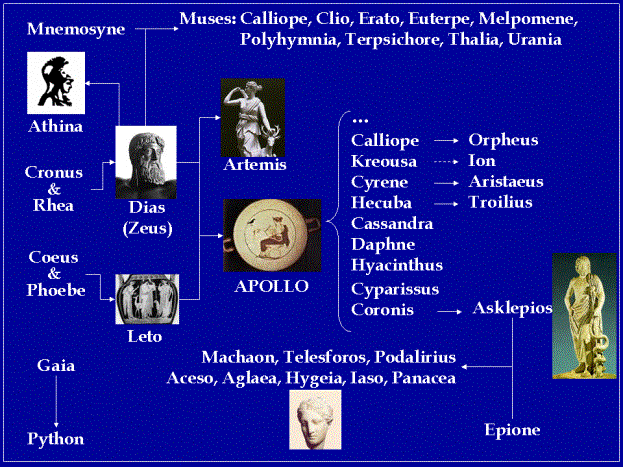
In ancient Greece, Apollo was one of the twelve gods and goddesses
of the Olympian pantheon (Greek gods had ichor in place of blood, the divine
substance running through the immortals’ veins, drank nectar and ate ambrosia).
According to Hesiod (Theogony, 918-20), Apollo, the son of Dias (Zeus) and
the Titaness Leto, was born with his twin sister Artemis, the Goddess of the
hunt and the moon, on the island of Delos. Dias, the youngest son of
Cronos and Rhea, was the supreme ruler of Mount Olympus, the spiritual leader
of both gods and men. His main attribute was the thunderbolt and other attributes,
apart from lightning, were the sceptre, the eagle and the aegis, the goat-skin of Amaltheia.
Leto was the daughter of the Titans Phoebe and Coeus. Dias’ wife, Hera being
jealous of Leto refused her to give birth on any ground. According to the
hymns to Apollo, the floating island of Delos was the only place willing to
accept to be birth-place of such a powerful god. Thus, Leto anchored Delos
to the bottom of the Aegean with four columns, to aid its stability.
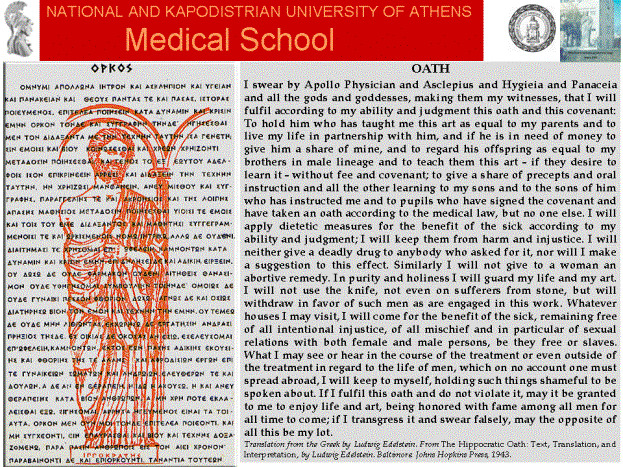
Apollo enjoyed eternal youth, beauty and good health. Temples and shrines
were raised in his honour throughout the ancient world. Most famous were his
birthplace, the isle of Delos, Delphi and the Asclepion on the isle
of Kos, where Hippocrates, the father of modern medicine, founded the
western world’s first medical school. The Hippocratic Oath, taken by
all doctors even to his day, is an oath to Apollo the Physician and to Asclepius and to Hygeia, the goddess
of Health, daughter of Asclepius. The cult centre Asclepion was named for
Asclepius, who was renowned for his knowledge and expertise in medicine.
His most famous sanctuary was in Epidaurus in the NE Peloponnesus. It is the
serpents of Asclepius that wrap around the caduceus, the staff of Hermes,
which has become the symbol of medicine in modern times. The bowl of Hygeia,
which has become the symbol of pharmacy, also bears Asclepius’ serpents.
Apollo, being a god of medicine and healing suggests an ancient association
with plague and its control. He was the father of Asklepios, by Coronis, whom
he killed when she was unfaithful. The unborn child was saved from the flames
of her funeral pyre and handed to the Centaur Chiron, who became his
tutor and mentor. According to the Pythian Odes of Pindar, Asclepius also
acquired the knowledge of surgery, the use of drugs, love potions and incantations.
According to Apollodorus, Athena gave Asclepius a magic potion made from the
blood of the Gorgon, which had a different effect depending from which side the blood was taken.
If taken from the right side, it could bring the dead back to life, but taken
from the left it was a deadly poison.
Apollo was also the patron god of the arts, music (principally the lyre),
poetry, archery (but not for war or hunting), prophecy and healing. His attributes
were the bow and arrows, the cithara (or lyre, which was given to him by Hermes
in compensation for the theft of his cattle), swans, wolves, dolphins and
the laurel crown. Apollo was associated with laurel, the plant used at his
festivals and in the rituals of the Delphic oracle, after the story of his
rape of Daphne (Gk for laurel or bay-tree). But his most famous attribute
was the tripod, the symbol of his prophetic powers. Being the god of prophecy,
he taught Cassandra the art of prophecy after she had promised to sleep
with him. Later, when she refused, he made her unable to convince anyone with
her prophecies. Amongst the many epithets and titles of Apollo the following
are the most common:
·
Phoebos (radiant
or beaming). Together with Athena, Apollo, under the name Phoevos, was designated
as a mascot of the 2004
Summer Olympics in Athens
·
Pythios, at Delphi
·
Delphinios (of the
womb; associating Apollo with Delphi and with dolphins in the Homeric hymns)
·
Musagetes. At Delphi
and the Parnassus he was the leader and the director of the choir of the Muses,
the daughters of Zeus and Mnemosyne, the goddesses
of memory, who inspired poets, philosophers and musicians. The number of Muses
varies over time; initially there was but one and later three nymphs in Pieria
(Melete, Mneme, Aoede), their cult brought to Helicon in Boeotia. Usually
there is mention of nine muses: Calliope, Clio, Erato, Euterpe, Melpomene,
Polymnia, Terpsichore,
Thalia, Urania.
·
Nymphegetes, looking
after the Nymphs: Daphne, Cyrene, Coronis, Castalia.
·
Loxias (oblique
- obscure, as god of prophecy)
·
Apotropaeus (who
averts evil)
·
Smintheus (Gk: sminthos
for mouse; destroyer of rats and bringer of the plague into the Greek camp
in Homer's Iliad)
·
Lykeios (Gk: lykos
for wolf; God of shepherds protecting the flocks)
Hymns and Paeans
to Apollo
The word hymn is derived from the Greek hymnos (Gk: hydein, to sing). Set
to the accompaniment of the Apollo's instrument, the kithara, at first it
was written in the epic measure like the oldest hymn to the Delphic Apollo,
later in distichs or in the refined lyric measures of Alcæus, Anacreon
and Pindar. The Paean was originally sung in honour of Apollo. In Homer, Paean was the physician
of the gods. In the Ancient Greek Dorian mode, the paean was accompanied by
the kithara. It was a choral ode and originally a leader sang in
a monodic style, with the chorus responding with a simple phrase. Later it
was an entirely choral form.
The Apollonian Hymns were stone inscriptions found in Delphi in 1893.
They were sung at the Pythian Games to commemorate Apollo's victory over the
Python, and in the springtime to celebrate Apollo's return to his sanctuary.
The First Delphic Hymn to Apollo was written by an Athenian composer,
around 138 B.C. In 1894, a year after it was discovered at Delphi by the French
School of Archaeology, Baron Pierre de Coubertin chose to have it performed
in an international athletic conference at the Sorbonne organised to promote
the idea of reviving the Olympic Games, thus offering an opportunity
to promote the ideals of friendship and the noble competition among nations.
The Second Delphic Hymn to Apollo, that has received more attention,
was composed by Limenios, around 128 B.C. The Athenian poet invites the Muses
to leave Mt Helicon in order to sing for Apollo in Mt Parnassus, narrates
the story of the God’s birth and while praising the god of Delphi he manages
to bring in the goddess of Athens Pallas.
The ancient
spirit that was expressed more than 25 centuries ago in Delphi still guides
art and science, thus confirming its diachronic significance.
